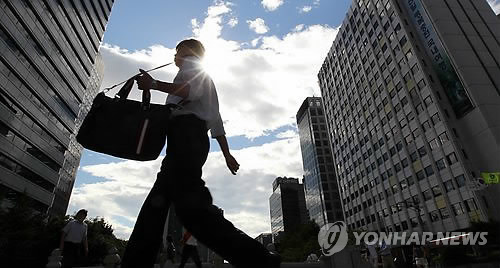About 1 in 7 workers in South Korea is paid the legal minimum wage or less, the highest rate among OECD member countries, a recent study showed.
According to the annual employment outlook by the Organization for Economic Cooperation and Development, nearly 15 percent of the Korean salaried workers were paid the minimum wage or less as of 2013, more than double the average rate of 5.5 percent among the surveyed 21 countries.
 |
| (Yonhap) |
The proportion for below-minimum wage workers in Korea was the highest in the OECD at 14.7 percent, followed by Latvia at 14.2 percent, Luxembourg at 12.3 percent and the Netherlands at 9 percent. Spain ranked the lowest on the list at 0.2 percent.
Published in July, the OECD Employment Outlook for this year reviewed recent labor market trends and prospects in the club of advanced economies by gathering data on the minimum wage of its 19 member nations and two others — Latvia and Colombia — working to join the group.
As of this month, 26 of the 34 member countries adopted some form of national minimum wage, with Germany being the latest addition.
In the report, the OECD underscored the importance of the minimum wage system as a means to raise living standards at the bottom of the earnings ladder. Those affected most by the legal rate are the young, women and low-educated workers with lower productivity and weak bargaining power, it pointed out.
In the United States, 4.3 percent of laborers were paid under the minimum wage, while 6.7 percent of Canadian workers were underpaid. Neighboring Japan only had 2 percent of salaried workers being underpaid.
Colombia saw nearly 34 percent of underpaid workers only in the public sector, with the figures for the whole labor market being unavailable.
Korean business leaders have cited an “excessively high minimum wage” as the reason behind the growing number of underpaid workers in Korea.
In Belgium, on the other hand, the minimum wage level was as high as its median wage of all salaried workers, but only 0.3 percent of the working population was paid below the legal rate.
Korea’s minimum wage ratio to median wage stands at 44.2 percent.
Korea has seen a fierce debate in recent months between employers and employees over the extent of next year’s minimum wage increase.
The labor bloc asked for a 79 percent rise from the current minimum wage at 5,580 won, arguing that the hike would curb the nation’s income inequality and boost consumer spending.
The business circle, however, campaigned for a freeze, citing possible job losses and soaring production costs, especially for smaller companies.
After months-long wrangling, the Minimum Wage Council, a trilateral group of employees, employers and labor experts, set the minimum wage for next year at 6,030 won, up 8.1 percent from this year’s rate.
The government will officially announce next year’s legal rate on Wednesday.
By Ock Hyun-ju (laeticia.ock@heraldcorp.com)



